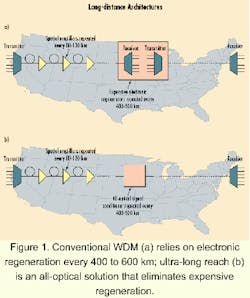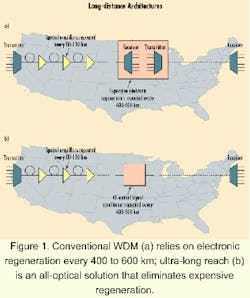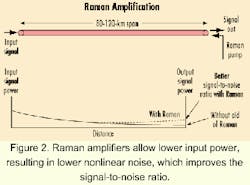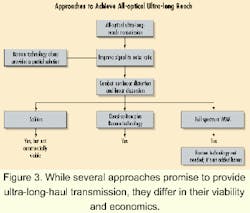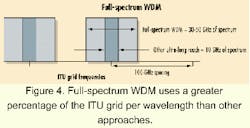Full-spectrum WDM provides ultra-long-reach all-optical transmission
A new technology provider obviates the need for Raman amplification in ultra-long-distance links.
Fei Zhu, Karl Ma, and Ilya Fishman
OptiMight Communications
To address this challenge, several equipment vendors have recently introduced all-optical transmission approaches for ultra-long-reach (ULR) applications. As shown in Figure 1, ULR technology is unlike conventional regeneration-based WDM that relies on expensive electronic regenerators to recondition the optical signal every 400-600 km. Instead, the optical pulse is manipulated to travel long distances without suffering irrecoverable deformation at the receiving terminal, thereby eliminating those expensive regenerators. Such an all-optical ULR system can reduce cost to one-half or one-tenth that of conventional WDM.
Improving the signal-to-noise ratio (SNR) is the keystone to accomplishing this achievement, and many equipment providers have turned to Raman amplification, a relatively new and powerful technology, to address the issue. While Raman amplification does indeed solve part of the problem, it alone cannot resolve more elemental problems related to the fundamental quality of transmitted optical signals.
Raman amplification is an important technology that could enable the continued increase in channel counts and data rates in ULR all-optical WDM. As seen in Figure 2, Raman amplification can be used to lower the required per-channel launch power by activating a portion of the inherently lossy fiber to one with incremental gain, thereby reducing the overall effective loss of that fiber span. From gain in the activated portion, the reduction in launch power still results in sufficient signal strength at the output of the fiber span, while fiber nonlinearity-induced impairments are reduced. The outcome is that SNR is improved so as to allow for a longer-distance all-optical transmission without requiring electronic regeneration.In essence, the hybrid erbium-doped fiber amplifier (EDFA)/Raman amplifier approach keeps signal propagation in transmission fibers as close to linear mode as possible (i.e., quasi-linear transmission) by limiting the per-channel launch power and relying on distributed Raman amplification to deliver the necessary signal strength. However, the boost from Raman amplification does not come for free-it has several drawbacks, including economic and implementation difficulties. Furthermore, the hybrid EDFA/Raman amplification approach alone does not directly resolve all-optical transmission issues. For example, multiple reflections within the fiber plant may get boosted along with the signal, causing inter-symbol interference and decreased signal performance.
Aside from relying on Raman to provide a "band-aid" solution, Figure 3 shows that improving the basic robustness of an optical signal (i.e., improving SNR) can be achieved only by dealing directly with the fundamental physics inherent in optical transmission through fiber-optic cables. In this general category, soliton technology was the first to successfully address the physics and led to the genesis of quasi, or dispersion-compensated, soliton technology. A new technology, full-spectrum WDM (FSWDM), extends the accomplishment of quasi-solitons.The idea of long-distance all-optical transmission first emerged in the 19th century, when it was observed that a wave originating at the mouth of a river could travel undeformed for miles up its banks under certain conditions. It was revealed that only when the riverbanks narrowed in a characteristic manner and the riverbed sloped in a particular fashion would such long-distance travel be feasible.
Scientists learned from this revelation that all-optical transmission also could be accomplished if nonlinear distortion and linear dispersion, two deleterious ef fects in optical transmission, could be used to continuously offset each other in a particular manner. Within the highly controlled regime of academic loop-experiments, these two effects were indeed offset precisely, and soliton signals were successfully transmitted in all-optical mode for several millions of kilometers.
It should be noted that solitons, and every other technology developed from its genealogy, relies on a return-to-zero (RZ) formatted signal. Simply said, an RZ pulse bears closest resemblance to the wave in that river and can be manipulated as discussed here, while non-RZ (NRZ) pulses can be made to travel longer distances only with the aid of Raman technology.
While solitons could indeed be used for all-optical transmission in the laboratory, they were commercially challenging because of the high expense incurred to continuously balance distortion against dispersion. Quasi-soliton technology emerged that partially ad dressed this problem. The newer ap proach recognized that as long as nonlinear distortion and linear dispersion were precisely compensated for in the end of each span, then concatenating spans together would result in a more feasible all-optical transmission solution.
The breakthrough lay in not having to precisely balance distortion and dispersion continuously-an expensive proposition-but to configure a scheme that would ensure precise compensation of these effects only at the ends of the span. Simply said, useful signal information is needed only at the ends of a quasi-soliton span without care as to what occurs in between. It is noted that the signal quality here is typically still not sufficient (i.e., the SNR is not sufficient) for long-distance transmissions, and Raman technology is needed to ensure successful transmissions. There are several carriers that have indeed implemented such commercial systems in their networks.
The quasi-soliton-plus-Raman approach continues to be challenging commercially and only partially because of the higher expense of Raman amplifiers. If compensation of dispersion and distortion are not precise at the ends of each span, then errors will accumulate over concatenated spans, leading to unusable signals at the final receiving terminal. Consequently, considerable expense is still incurred to map out real-world networks in detail and tune each span to those network characteristics.
FSWDM "decouples" the deleterious effects of nonlinear distortion and chromatic dispersion and deals with each separately. In this manner, FSWDM eliminates the need for precise dispersion management at each fiber span, while being able to accommodate the errors that accumulate in each section. Consequently, a much simpler, more flexible, lower-cost system is feasible. It should be noted that the gain in SNR performance is sufficient so that FSWDM does not require Raman technology for ULR OC-192 transmission. On the other hand, Raman may be incorporated in FSWDM to accomplish other ends.
As seen in Figure 4, "full-spectrum" refers to the fact that FSWDM uses upwards of 30 to 50 GHz of a 100-GHz-spaced ITU grid to carry an OC-192 signal. This spectral enrichment, made possible by manipulating data pulses in both frequency and time domains, results in some unique attri-butes. In the frequency domain, it reduces spectral power density (i.e., spectral brightness) so that more power per channel can be allowed without the typical increase in nonlinear distortion. In the time domain, it creates super-fine structures within each data pulse, while effectively eliminating coherence problems among all the super-fine phase modulations.As a result, FSWDM channels are effectively de-correlated, and their propagation in the transmission fiber is essentially free of cross-phase modulation (XPM) and four-wave mixing (FWM) effects. XPM and FWM are two of the principal impairments in an ULR DWDM transport system. Furthermore, with appropriate control of the frequency and time-domain modulations, FSWDM pulses are capable of eliminating the accumulated effects of self-phase modulation and other impairments.
Linear dispersion, on the other hand, has to be somewhat managed with dispersion-compensation modules (DCMs) at the end of each span. However, precise control is not needed, as a final DCM at the receiving terminal can be used to correct for accumulated errors.
In FSWDM, the aggregate system noise determines the ultimate transmission distance that can be achieved. This relationship is opposed to all other solutions that depend on how accurately distortion and dispersion can be managed to determine transmission distance. Consequently, longer reach can be achieved with the simpler approach of using quieter components, rather than by having to more precisely manage signal quality.
In short, because FSWDM pulses allow more per-channel launch power into the fiber, while keeping the transmission essentially free of nonlinear impairments (i.e., signal power is increased and noise reduced), Raman amplification and precise dispersion management are not needed. This approach solves the fundamental issues confronting ULR DWDM transmission.
FSWDM's Raman-less approach is unique in the ULR category and provides benefits not offered by other solutions. It should be noted that because FSWDM is in essence simply a cleaner way to transmit more robust optical signals, it is basically also transparent to most other infrastructure issues.
Consequently, FSWDM will likely play an increasingly important role in optical transport as more evolved amplifiers, more advanced fiber-optic cables, or different operating bands become commercially viable. These advancements would inevitably be needed to enable simpler networks with more capacity, greater flexibility, and lower cost.
Fei Zhu is systems engineering manager, Karl Ma is product-development director, and Ilya Fishman is president and chief technical officer at OptiMight Communications (San Jose, CA).
